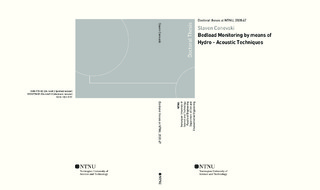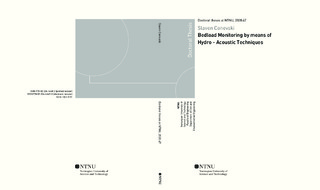| dc.contributor.advisor | Ruther, Nils | |
| dc.contributor.advisor | Guerrero, Massimo | |
| dc.contributor.author | Conevski, Slaven | |
| dc.date.accessioned | 2020-02-20T12:00:06Z | |
| dc.date.available | 2020-02-20T12:00:06Z | |
| dc.date.issued | 2020 | |
| dc.identifier.isbn | 978-82-326-4449-0 | |
| dc.identifier.issn | 1503-8181 | |
| dc.identifier.uri | http://hdl.handle.net/11250/2642902 | |
| dc.description.abstract | The bedload distribution through the alluvial streams contributes in shaping of the river morphology. Therefore, bedload transport data are fundamental requirement for proper management of engineering practices in complex river systems. However, measurement series of bedload transport are seldom available and therefore statistically unreliable. The conventional methods can be notoriously hard and labor-intensive, entailing significant stochastic and systematic uncertainties mostly due to the spatio-temporal variability of the bedload as well as the instrument direct disturbance of the riverbed. Thus, the use of non-intrusive surrogate techniques could significantly reduce that uncertainty.
Recently, many studies have demonstrated that the hydro-acoustics instruments are promising technique for bedload measurement. These sensors do not disturb the riverbed and are easy-to-deploy for long and frequent measurements. Some studies have reported strong correlations between the acoustic Doppler current profilers (ADCP) bedload measurements and the conventional bedload samplers. However, most of these methods are site-specific and require detailed calibration. This study investigates the capability of different ADCPs to measure the bedload velocity and bedload concentration. For those purposes, two laboratory and several field campaigns were conducted. The first series of laboratory experiments were performed in the hydraulic laboratories at UNIBO and UOttawa, focusing on evaluation of the apparent bedload velocity and the scattering processes occurring at the riverbed. The second campaign was conducted at NTNU laboratory aiming to validate the previous results and to further examine the acoustic parameters and signal processing configurations. At the same time the backscattering strength sensitivity towards the bedload concentration was fully examined. Two ADCPs were deployed at the same time on 0.7 m mutual distance (M9 Sontek, 1 MHz and 3 MHz and Stream Pro RDI, 2 MHz). Side and planar looking camera were deployed to measure the bedload velocity, active layer thickness and surface bedload concentration and a bedload trap was installed at the end of the flume to monitor the bedload transport rate. Different bedload transport conditions were reached by utilizing various sediment materials, (e.g., sand and gravel) and by adjusting the hydraulic conditions. De-spiking and filtering were applied to the raw data, and the temporal average of the apparent bedload velocity was spatially normalized. The percentage of filtered erroneous velocity data from the ADCP time series demonstrated a strong correlation with the surface concentration of mobile particles. In all experiments the normalized apparent velocities measured by the M9 corresponded well to the bedload velocity of the imagery data, better than those measured by the StreamPro, which appeared to underestimate the bedload velocity by a factor of 2-22. These deviations resulted from the different signal processing configurations, the acoustic geometry, and the immobile sediment bed. The backscattering (BS) strength was de-spiked and corrected by adapting the basic sonar equation for riverbed scattering. For the M9 the BS strength decreased as the bedload concentration increased, independently of the particle velocities and sizes. The BS strength registered by the StreamPro resulted in almost constant values for all transport conditions. Additional tests were performed using ultrasound velocity profilers developed by Ubertone. These results confirmed that the internal pressing and echo profiling resolution are crucial in the determination of the correct bedload velocity.
The field experiments were conducted in two relatively large rivers in Germany (Oder and Elbe River) and in one small river in Albania (Tommorice River). Stationary measurements were performed using four different ADCPs (M9 Sontek, Rio Grande RDI 0.6 MHz and 1.2 MHz, RiverPro RDI 1.2 MHz) working at four different frequencies. The raw apparent bedload velocities were de-spiked and filtered in a stream-wise direction. Then, functional correlations were observed between the magnitudes of the apparent velocities and the bedload transport rates measured by pressure-difference bedload sampler. Each ADCP yielded different results because of the different frequency, backscatter sensitivity and acoustic penetration in the active bedload layer. In addition to the frequency, other acoustic parameters such as the percentage of the filtered data, transducers width, beamopening and grazing angle, the pulse length, contributed to the different acoustic bedload sampling. More precisely, the lower apparent bedload velocity was obtained when lower acoustic frequency, longer pulse lengths and larger beam focusing were used. The kinematic model was successfully applied for the middle frequencies (1.2 MHz and 1 MHz), which gave the best correspondence to the empirical estimation of the bedload active layer thickness and concentration. The field data helped to understand the influence of the riverbed deformation as well as the acoustic sampling problems.
The future research should focus on a more extensive examination of the internal processing algorithms to eventually clarify the best processing configuration and use of the ADCPs. Therefore, closer cooperation between the researchers and the manufacturers of the ADCPs is fundamental for better understanding and possible adaptation of the ADCPs to measure even more accurately the bedload velocity and BS strength. A complete model of bedload transport rate based on apparent velocity and BS strength should be fully developed in addition to further testing of the BS strength. | nb_NO |
| dc.language.iso | eng | nb_NO |
| dc.publisher | NTNU | nb_NO |
| dc.relation.ispartofseries | Doctoral theses at NTNU;2020:47 | |
| dc.relation.haspart | Paper 1: Conevski, Slaven; Guerrero, Massimo; Ruther, Nils; Rennie, Colin. Laboratory investigation of the apparent bedload velocity measured by ADCPs under different transport conditions. Journal of Hydraulic Engineering 2019 ;Volum 145.(11)
https://doi.org/10.1061/(ASCE)HY.1943-7900.0001632 | nb_NO |
| dc.relation.haspart | Paper 2: Conevski, Slaven; Guerrero, Massimo; Winterscheid, Axel; Rennie, Colin; Ruther, Nils. Acoustic sampling effects on bedload quantification using acoustic Doppler current profilers. Journal of Hydraulic Research 2020
https://doi.org/10.1080/00221686.2019.1703047 | nb_NO |
| dc.relation.haspart | Paper 3: Conevski, Slaven; Ruther, Nils; Winterscheid, Axel; Guerrero, Massimo; Rennie, Colin. Evaluation of an acoustic Doppler technique for bed-load transport measurements in sand-bed Rivers. RiverFlow 2018
https://doi.org/10.1051/e3sconf/20184002053
- This is an Open Access article distributed under the terms of the Creative Commons Attribution License 4.0 (CC BY 4.0) | nb_NO |
| dc.relation.haspart | Paper 4: Conevski, Slaven; Guerrero, Massimo; Ruther, Nils; Rennie, Colin.
Laboratory Monitoring of Bedload Transport Rates by Means of Hydro-acoustic Techniques
(ADCP). IHAR World Congress; 2019 | nb_NO |
| dc.relation.haspart | Paper 5:
Conevski, Slaven; Guerrero, Massimo; Rennie, Colin.D; Ruther, Nils.
Towards evaluation of bedload transport characteristics by using velocity and backscatter outputs from ADCPs | nb_NO |
| dc.relation.haspart | Paper 6:
Conevski, Slaven; Guerrero, Massimo; Burckbuchler, Marie; Ruther, Nils.
Bedload measurements using ultrasound Velocity profilers (UVP) in controlled laboratory conditions.
Proceedings from Particles in Europe
PiE 2018 | |
| dc.title | Bedload Monitoring by means of Hydro - Acoustic Techniques | nb_NO |
| dc.type | Doctoral thesis | nb_NO |
| dc.subject.nsi | VDP::Technology: 500::Environmental engineering: 610 | nb_NO |

